MGMT20140 - Design Thinking: Reflective Report on Learning & Growth
VerifiedAdded on 2023/06/03
|14
|3583
|403
Report
AI Summary
This report presents a student's reflective journey through a design thinking course (MGMT20140). It covers knowledge development, critical analysis of design thinking processes, and personal development through teamwork and problem-solving activities. The reflection incorporates insights from weekly blog entries, addressing strengths and weaknesses, and culminates in an action plan for future development. Key areas explored include empathy mapping, fixed vs. growth mindset, and the importance of data and customer research in business. The assignment demonstrates the student's ability to connect theory to practice and critically evaluate their own learning experience.
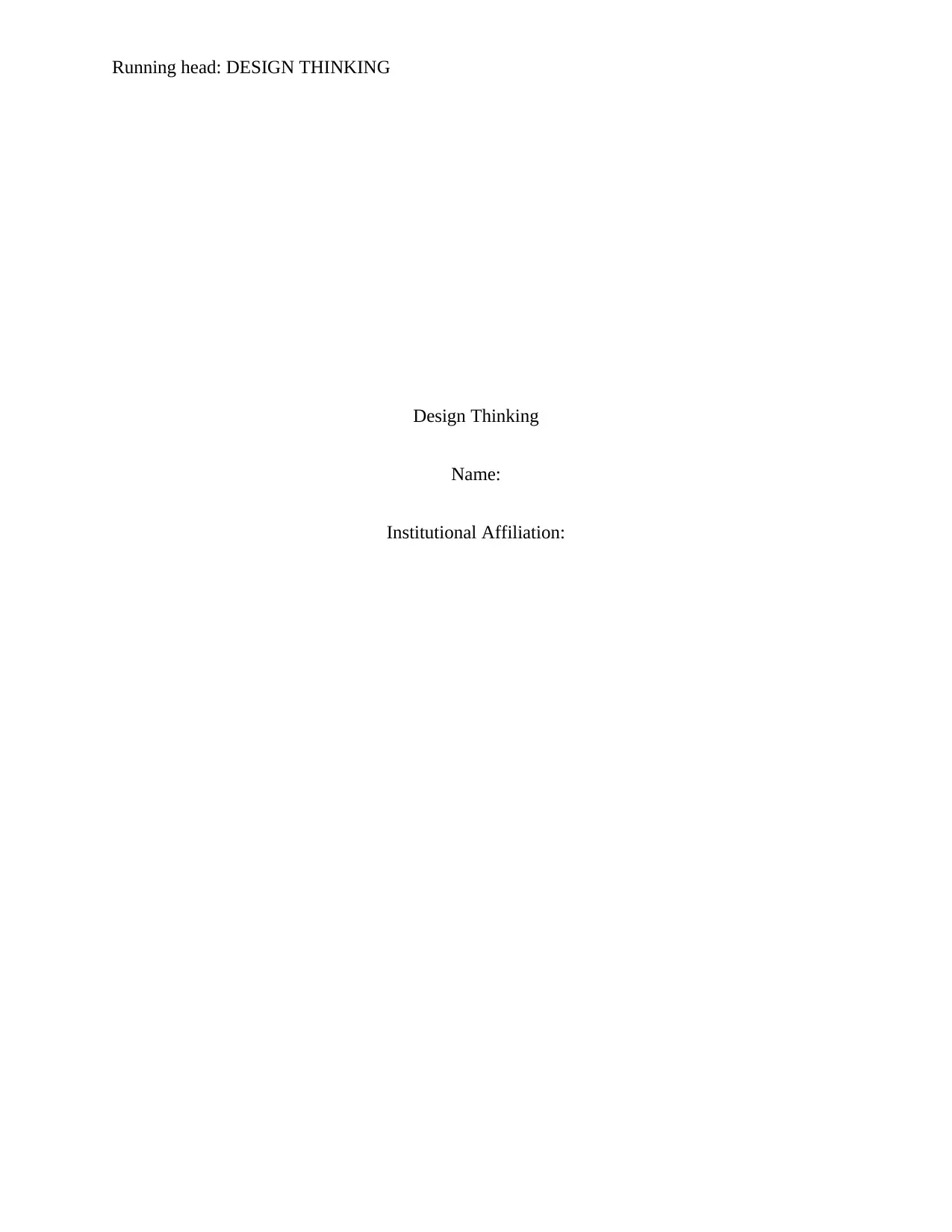
Running head: DESIGN THINKING
Design Thinking
Name:
Institutional Affiliation:
Design Thinking
Name:
Institutional Affiliation:
Paraphrase This Document
Need a fresh take? Get an instant paraphrase of this document with our AI Paraphraser
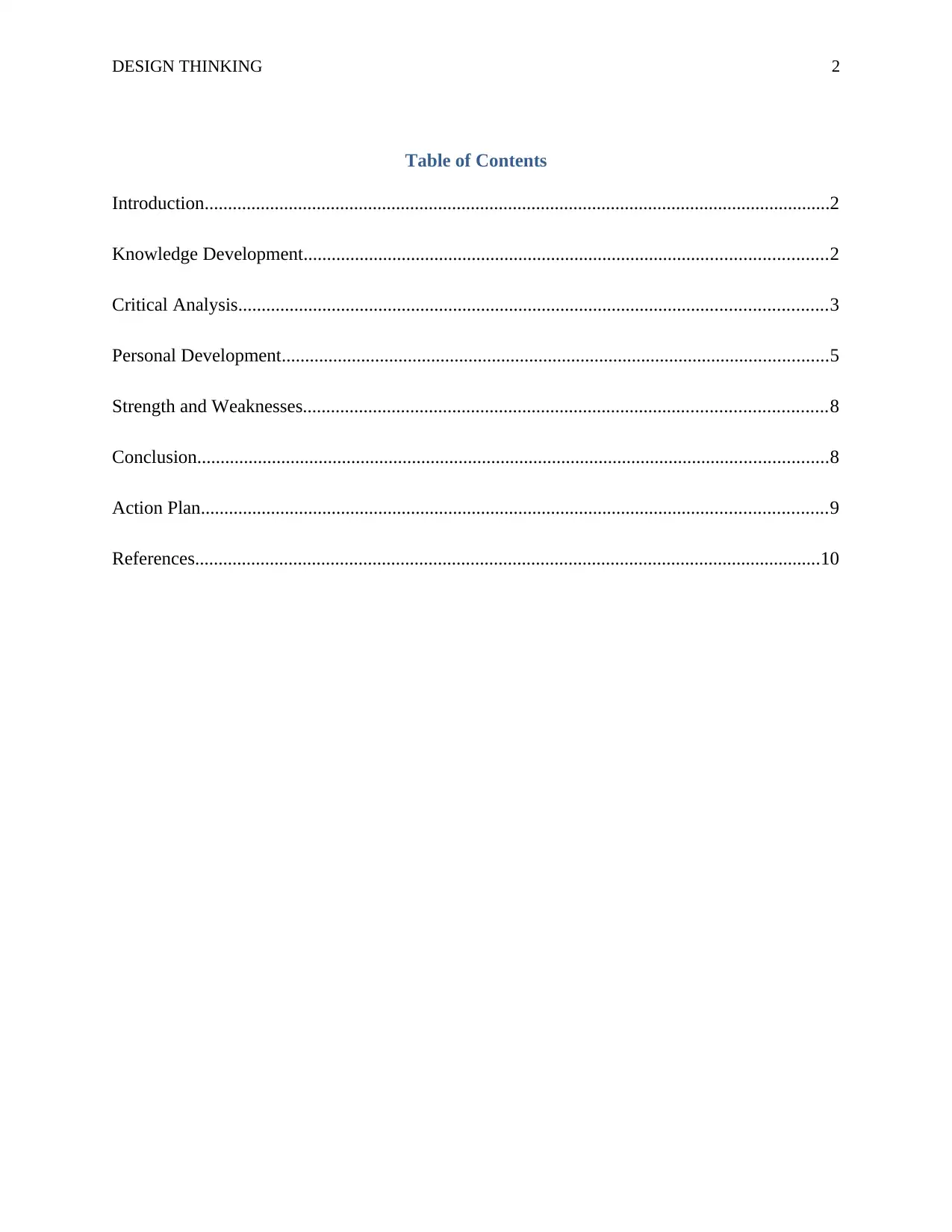
DESIGN THINKING 2
Table of Contents
Introduction......................................................................................................................................2
Knowledge Development................................................................................................................2
Critical Analysis..............................................................................................................................3
Personal Development.....................................................................................................................5
Strength and Weaknesses................................................................................................................8
Conclusion.......................................................................................................................................8
Action Plan......................................................................................................................................9
References......................................................................................................................................10
Table of Contents
Introduction......................................................................................................................................2
Knowledge Development................................................................................................................2
Critical Analysis..............................................................................................................................3
Personal Development.....................................................................................................................5
Strength and Weaknesses................................................................................................................8
Conclusion.......................................................................................................................................8
Action Plan......................................................................................................................................9
References......................................................................................................................................10

DESIGN THINKING 3
Introduction
Personal reflective writing involves writing assignments and exercises that are self-
referential or self-reflective in nature (Lawrence, 2013). The articles involve the writer writing
about their own experience in different activities. Tembrioti and Tsangaridou (2014) emphasized
that reflective practice is very significant for the professional competency. The ability to reflect
on what one has done is important than practicing a routine. In this paper, I was able to write
about some of my achievement, weaknesses and strengths from what I have learnt in the design
thinking class. It is based on a personal assessment of the different activities that have occurred
in class. The ability to reflect on one’s learning enhances the critical thinking skills.
Knowledge Development
In the first week of my studies, I learnt about design thinking foundation, where the
whole unit was explained in details, what to expect at the end of the unit, and the objectives and
goals of the unit were also established. I got to understand the meaning of design thinking.
Which is the method used to provide a solution-based approach to solving problems? Before this
class, I never thought there are criteria for finding solutions to problems. Also from the activity,
we did in class where, in groups of 3 we wrote three points of business and converted it into a
diagram. I got to learn share writing from the group members. At first, I was skeptical on how
whole group discussion was going to turn out. I was afraid my group members would be
judgmental and not consider all the ideas. But as it turned out, they’re very cooperative, and all
the ideas were considered as we brainstormed together. What amazed me most was how quick
were able to accommodate one another and think abstractly in coming up with the ideas. The
Introduction
Personal reflective writing involves writing assignments and exercises that are self-
referential or self-reflective in nature (Lawrence, 2013). The articles involve the writer writing
about their own experience in different activities. Tembrioti and Tsangaridou (2014) emphasized
that reflective practice is very significant for the professional competency. The ability to reflect
on what one has done is important than practicing a routine. In this paper, I was able to write
about some of my achievement, weaknesses and strengths from what I have learnt in the design
thinking class. It is based on a personal assessment of the different activities that have occurred
in class. The ability to reflect on one’s learning enhances the critical thinking skills.
Knowledge Development
In the first week of my studies, I learnt about design thinking foundation, where the
whole unit was explained in details, what to expect at the end of the unit, and the objectives and
goals of the unit were also established. I got to understand the meaning of design thinking.
Which is the method used to provide a solution-based approach to solving problems? Before this
class, I never thought there are criteria for finding solutions to problems. Also from the activity,
we did in class where, in groups of 3 we wrote three points of business and converted it into a
diagram. I got to learn share writing from the group members. At first, I was skeptical on how
whole group discussion was going to turn out. I was afraid my group members would be
judgmental and not consider all the ideas. But as it turned out, they’re very cooperative, and all
the ideas were considered as we brainstormed together. What amazed me most was how quick
were able to accommodate one another and think abstractly in coming up with the ideas. The
⊘ This is a preview!⊘
Do you want full access?
Subscribe today to unlock all pages.

Trusted by 1+ million students worldwide
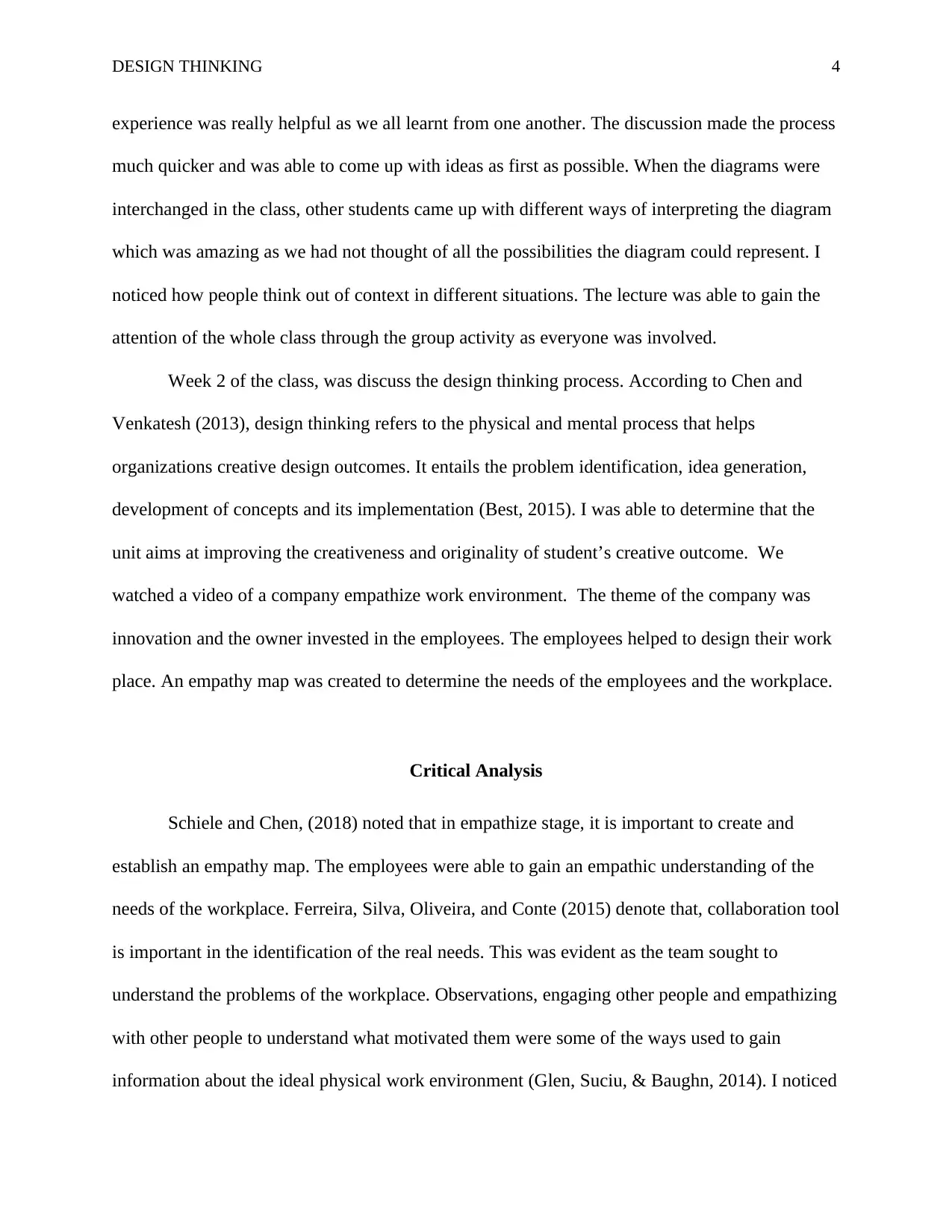
DESIGN THINKING 4
experience was really helpful as we all learnt from one another. The discussion made the process
much quicker and was able to come up with ideas as first as possible. When the diagrams were
interchanged in the class, other students came up with different ways of interpreting the diagram
which was amazing as we had not thought of all the possibilities the diagram could represent. I
noticed how people think out of context in different situations. The lecture was able to gain the
attention of the whole class through the group activity as everyone was involved.
Week 2 of the class, was discuss the design thinking process. According to Chen and
Venkatesh (2013), design thinking refers to the physical and mental process that helps
organizations creative design outcomes. It entails the problem identification, idea generation,
development of concepts and its implementation (Best, 2015). I was able to determine that the
unit aims at improving the creativeness and originality of student’s creative outcome. We
watched a video of a company empathize work environment. The theme of the company was
innovation and the owner invested in the employees. The employees helped to design their work
place. An empathy map was created to determine the needs of the employees and the workplace.
Critical Analysis
Schiele and Chen, (2018) noted that in empathize stage, it is important to create and
establish an empathy map. The employees were able to gain an empathic understanding of the
needs of the workplace. Ferreira, Silva, Oliveira, and Conte (2015) denote that, collaboration tool
is important in the identification of the real needs. This was evident as the team sought to
understand the problems of the workplace. Observations, engaging other people and empathizing
with other people to understand what motivated them were some of the ways used to gain
information about the ideal physical work environment (Glen, Suciu, & Baughn, 2014). I noticed
experience was really helpful as we all learnt from one another. The discussion made the process
much quicker and was able to come up with ideas as first as possible. When the diagrams were
interchanged in the class, other students came up with different ways of interpreting the diagram
which was amazing as we had not thought of all the possibilities the diagram could represent. I
noticed how people think out of context in different situations. The lecture was able to gain the
attention of the whole class through the group activity as everyone was involved.
Week 2 of the class, was discuss the design thinking process. According to Chen and
Venkatesh (2013), design thinking refers to the physical and mental process that helps
organizations creative design outcomes. It entails the problem identification, idea generation,
development of concepts and its implementation (Best, 2015). I was able to determine that the
unit aims at improving the creativeness and originality of student’s creative outcome. We
watched a video of a company empathize work environment. The theme of the company was
innovation and the owner invested in the employees. The employees helped to design their work
place. An empathy map was created to determine the needs of the employees and the workplace.
Critical Analysis
Schiele and Chen, (2018) noted that in empathize stage, it is important to create and
establish an empathy map. The employees were able to gain an empathic understanding of the
needs of the workplace. Ferreira, Silva, Oliveira, and Conte (2015) denote that, collaboration tool
is important in the identification of the real needs. This was evident as the team sought to
understand the problems of the workplace. Observations, engaging other people and empathizing
with other people to understand what motivated them were some of the ways used to gain
information about the ideal physical work environment (Glen, Suciu, & Baughn, 2014). I noticed
Paraphrase This Document
Need a fresh take? Get an instant paraphrase of this document with our AI Paraphraser
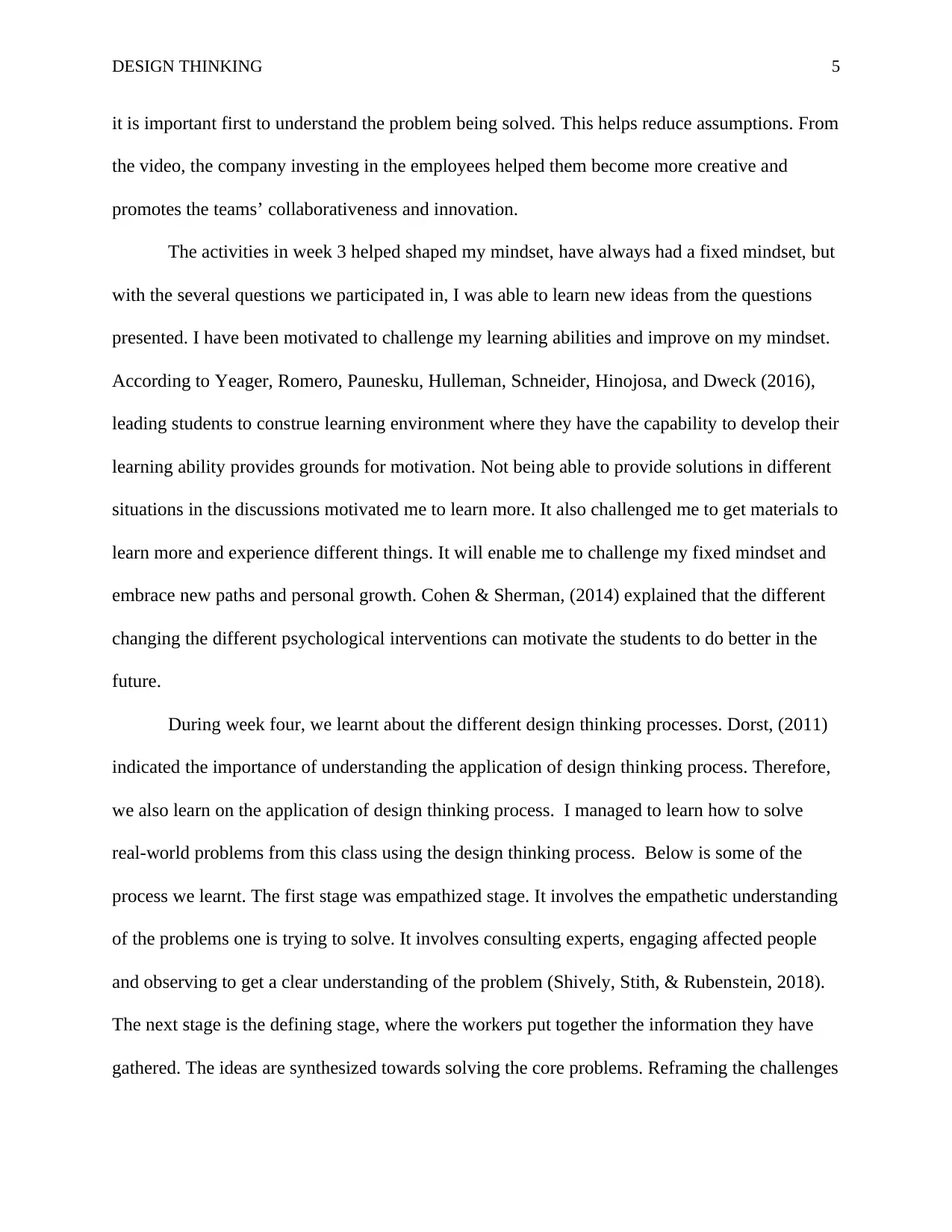
DESIGN THINKING 5
it is important first to understand the problem being solved. This helps reduce assumptions. From
the video, the company investing in the employees helped them become more creative and
promotes the teams’ collaborativeness and innovation.
The activities in week 3 helped shaped my mindset, have always had a fixed mindset, but
with the several questions we participated in, I was able to learn new ideas from the questions
presented. I have been motivated to challenge my learning abilities and improve on my mindset.
According to Yeager, Romero, Paunesku, Hulleman, Schneider, Hinojosa, and Dweck (2016),
leading students to construe learning environment where they have the capability to develop their
learning ability provides grounds for motivation. Not being able to provide solutions in different
situations in the discussions motivated me to learn more. It also challenged me to get materials to
learn more and experience different things. It will enable me to challenge my fixed mindset and
embrace new paths and personal growth. Cohen & Sherman, (2014) explained that the different
changing the different psychological interventions can motivate the students to do better in the
future.
During week four, we learnt about the different design thinking processes. Dorst, (2011)
indicated the importance of understanding the application of design thinking process. Therefore,
we also learn on the application of design thinking process. I managed to learn how to solve
real-world problems from this class using the design thinking process. Below is some of the
process we learnt. The first stage was empathized stage. It involves the empathetic understanding
of the problems one is trying to solve. It involves consulting experts, engaging affected people
and observing to get a clear understanding of the problem (Shively, Stith, & Rubenstein, 2018).
The next stage is the defining stage, where the workers put together the information they have
gathered. The ideas are synthesized towards solving the core problems. Reframing the challenges
it is important first to understand the problem being solved. This helps reduce assumptions. From
the video, the company investing in the employees helped them become more creative and
promotes the teams’ collaborativeness and innovation.
The activities in week 3 helped shaped my mindset, have always had a fixed mindset, but
with the several questions we participated in, I was able to learn new ideas from the questions
presented. I have been motivated to challenge my learning abilities and improve on my mindset.
According to Yeager, Romero, Paunesku, Hulleman, Schneider, Hinojosa, and Dweck (2016),
leading students to construe learning environment where they have the capability to develop their
learning ability provides grounds for motivation. Not being able to provide solutions in different
situations in the discussions motivated me to learn more. It also challenged me to get materials to
learn more and experience different things. It will enable me to challenge my fixed mindset and
embrace new paths and personal growth. Cohen & Sherman, (2014) explained that the different
changing the different psychological interventions can motivate the students to do better in the
future.
During week four, we learnt about the different design thinking processes. Dorst, (2011)
indicated the importance of understanding the application of design thinking process. Therefore,
we also learn on the application of design thinking process. I managed to learn how to solve
real-world problems from this class using the design thinking process. Below is some of the
process we learnt. The first stage was empathized stage. It involves the empathetic understanding
of the problems one is trying to solve. It involves consulting experts, engaging affected people
and observing to get a clear understanding of the problem (Shively, Stith, & Rubenstein, 2018).
The next stage is the defining stage, where the workers put together the information they have
gathered. The ideas are synthesized towards solving the core problems. Reframing the challenges

DESIGN THINKING 6
at hand is also practice. I managed to learn to consider the challenges experienced before rushing
into possible solutions. The next stage ideates this where the teams come up with ideas and think
out of the box for solutions. Brainstorming together helps create and evaluate different ideas
needed. This is where creativity is key, as people brainstorm creative and unique ideas to try to
solve the problem (Liedtka, 2015). There is more to just idea generation, but we have to think
more than the ideas. One got to think of all the possible outcomes and the different impacts of
the ideas.
Personal Development
The prototype and testing stage involved the experimentation of the solutions (Stickdorn
& Schneider, 2011). The main purpose of the prototype stage is to receive different feedbacks of
the ideas generated. Then make the additional revisions and get to learn how the idea is
perceived by the intended audience (Cross, 2011). They’re able to investigate the different ideas
generated and improve or reject an idea. It is the stage where the most preferred idea based on
the user’s experiences is improved and developed as they have an idea of the developing
problems, and how the users interact with the idea (Kim & Ryu, 2014). From this stage, I have
learnt to always share the ideas with other people in order to gain feedback. The feedbacks help
understand the perception of the intended audience (Adams & Nash, 2016). This class provided
the useful process of solving problems using design thinking and also showed the importance of
companies being committed to their themes. They support the employees and involve them by
providing opportunities where they can be creative and innovative to the company.
We were able to work as a team which made the whole process interesting. We followed
the steps of design thinking and came up with recommendations for solving the problems.
at hand is also practice. I managed to learn to consider the challenges experienced before rushing
into possible solutions. The next stage ideates this where the teams come up with ideas and think
out of the box for solutions. Brainstorming together helps create and evaluate different ideas
needed. This is where creativity is key, as people brainstorm creative and unique ideas to try to
solve the problem (Liedtka, 2015). There is more to just idea generation, but we have to think
more than the ideas. One got to think of all the possible outcomes and the different impacts of
the ideas.
Personal Development
The prototype and testing stage involved the experimentation of the solutions (Stickdorn
& Schneider, 2011). The main purpose of the prototype stage is to receive different feedbacks of
the ideas generated. Then make the additional revisions and get to learn how the idea is
perceived by the intended audience (Cross, 2011). They’re able to investigate the different ideas
generated and improve or reject an idea. It is the stage where the most preferred idea based on
the user’s experiences is improved and developed as they have an idea of the developing
problems, and how the users interact with the idea (Kim & Ryu, 2014). From this stage, I have
learnt to always share the ideas with other people in order to gain feedback. The feedbacks help
understand the perception of the intended audience (Adams & Nash, 2016). This class provided
the useful process of solving problems using design thinking and also showed the importance of
companies being committed to their themes. They support the employees and involve them by
providing opportunities where they can be creative and innovative to the company.
We were able to work as a team which made the whole process interesting. We followed
the steps of design thinking and came up with recommendations for solving the problems.
⊘ This is a preview!⊘
Do you want full access?
Subscribe today to unlock all pages.

Trusted by 1+ million students worldwide
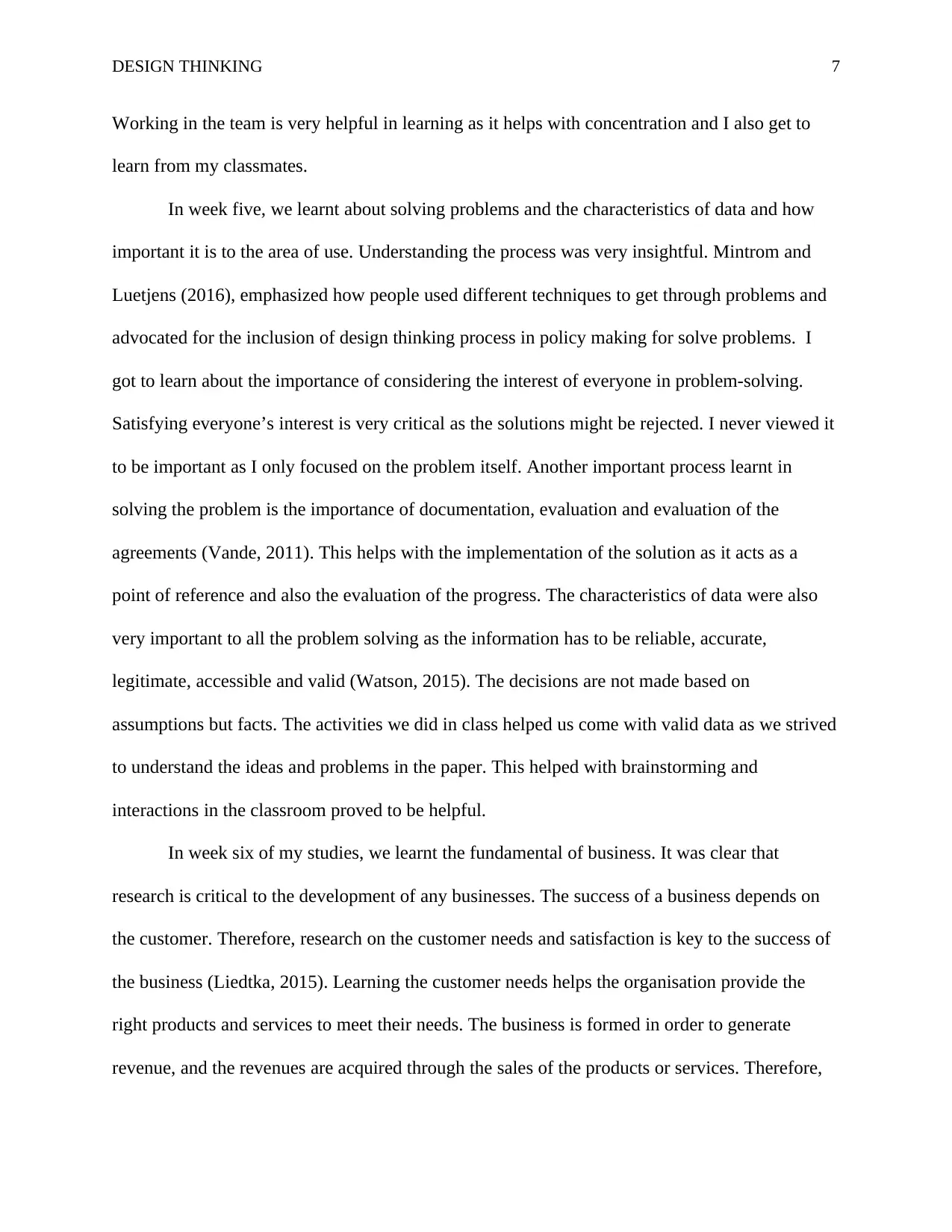
DESIGN THINKING 7
Working in the team is very helpful in learning as it helps with concentration and I also get to
learn from my classmates.
In week five, we learnt about solving problems and the characteristics of data and how
important it is to the area of use. Understanding the process was very insightful. Mintrom and
Luetjens (2016), emphasized how people used different techniques to get through problems and
advocated for the inclusion of design thinking process in policy making for solve problems. I
got to learn about the importance of considering the interest of everyone in problem-solving.
Satisfying everyone’s interest is very critical as the solutions might be rejected. I never viewed it
to be important as I only focused on the problem itself. Another important process learnt in
solving the problem is the importance of documentation, evaluation and evaluation of the
agreements (Vande, 2011). This helps with the implementation of the solution as it acts as a
point of reference and also the evaluation of the progress. The characteristics of data were also
very important to all the problem solving as the information has to be reliable, accurate,
legitimate, accessible and valid (Watson, 2015). The decisions are not made based on
assumptions but facts. The activities we did in class helped us come with valid data as we strived
to understand the ideas and problems in the paper. This helped with brainstorming and
interactions in the classroom proved to be helpful.
In week six of my studies, we learnt the fundamental of business. It was clear that
research is critical to the development of any businesses. The success of a business depends on
the customer. Therefore, research on the customer needs and satisfaction is key to the success of
the business (Liedtka, 2015). Learning the customer needs helps the organisation provide the
right products and services to meet their needs. The business is formed in order to generate
revenue, and the revenues are acquired through the sales of the products or services. Therefore,
Working in the team is very helpful in learning as it helps with concentration and I also get to
learn from my classmates.
In week five, we learnt about solving problems and the characteristics of data and how
important it is to the area of use. Understanding the process was very insightful. Mintrom and
Luetjens (2016), emphasized how people used different techniques to get through problems and
advocated for the inclusion of design thinking process in policy making for solve problems. I
got to learn about the importance of considering the interest of everyone in problem-solving.
Satisfying everyone’s interest is very critical as the solutions might be rejected. I never viewed it
to be important as I only focused on the problem itself. Another important process learnt in
solving the problem is the importance of documentation, evaluation and evaluation of the
agreements (Vande, 2011). This helps with the implementation of the solution as it acts as a
point of reference and also the evaluation of the progress. The characteristics of data were also
very important to all the problem solving as the information has to be reliable, accurate,
legitimate, accessible and valid (Watson, 2015). The decisions are not made based on
assumptions but facts. The activities we did in class helped us come with valid data as we strived
to understand the ideas and problems in the paper. This helped with brainstorming and
interactions in the classroom proved to be helpful.
In week six of my studies, we learnt the fundamental of business. It was clear that
research is critical to the development of any businesses. The success of a business depends on
the customer. Therefore, research on the customer needs and satisfaction is key to the success of
the business (Liedtka, 2015). Learning the customer needs helps the organisation provide the
right products and services to meet their needs. The business is formed in order to generate
revenue, and the revenues are acquired through the sales of the products or services. Therefore,
Paraphrase This Document
Need a fresh take? Get an instant paraphrase of this document with our AI Paraphraser
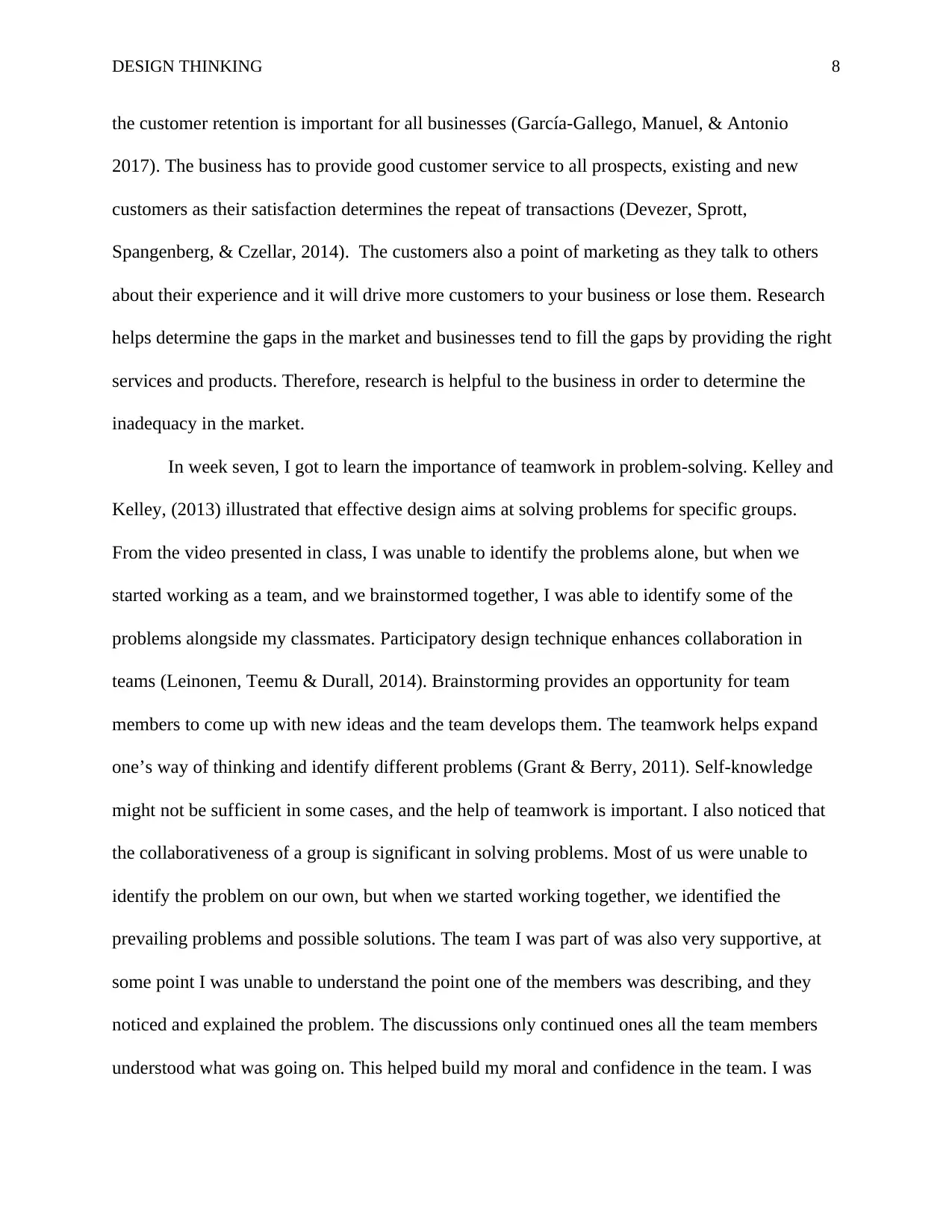
DESIGN THINKING 8
the customer retention is important for all businesses (García-Gallego, Manuel, & Antonio
2017). The business has to provide good customer service to all prospects, existing and new
customers as their satisfaction determines the repeat of transactions (Devezer, Sprott,
Spangenberg, & Czellar, 2014). The customers also a point of marketing as they talk to others
about their experience and it will drive more customers to your business or lose them. Research
helps determine the gaps in the market and businesses tend to fill the gaps by providing the right
services and products. Therefore, research is helpful to the business in order to determine the
inadequacy in the market.
In week seven, I got to learn the importance of teamwork in problem-solving. Kelley and
Kelley, (2013) illustrated that effective design aims at solving problems for specific groups.
From the video presented in class, I was unable to identify the problems alone, but when we
started working as a team, and we brainstormed together, I was able to identify some of the
problems alongside my classmates. Participatory design technique enhances collaboration in
teams (Leinonen, Teemu & Durall, 2014). Brainstorming provides an opportunity for team
members to come up with new ideas and the team develops them. The teamwork helps expand
one’s way of thinking and identify different problems (Grant & Berry, 2011). Self-knowledge
might not be sufficient in some cases, and the help of teamwork is important. I also noticed that
the collaborativeness of a group is significant in solving problems. Most of us were unable to
identify the problem on our own, but when we started working together, we identified the
prevailing problems and possible solutions. The team I was part of was also very supportive, at
some point I was unable to understand the point one of the members was describing, and they
noticed and explained the problem. The discussions only continued ones all the team members
understood what was going on. This helped build my moral and confidence in the team. I was
the customer retention is important for all businesses (García-Gallego, Manuel, & Antonio
2017). The business has to provide good customer service to all prospects, existing and new
customers as their satisfaction determines the repeat of transactions (Devezer, Sprott,
Spangenberg, & Czellar, 2014). The customers also a point of marketing as they talk to others
about their experience and it will drive more customers to your business or lose them. Research
helps determine the gaps in the market and businesses tend to fill the gaps by providing the right
services and products. Therefore, research is helpful to the business in order to determine the
inadequacy in the market.
In week seven, I got to learn the importance of teamwork in problem-solving. Kelley and
Kelley, (2013) illustrated that effective design aims at solving problems for specific groups.
From the video presented in class, I was unable to identify the problems alone, but when we
started working as a team, and we brainstormed together, I was able to identify some of the
problems alongside my classmates. Participatory design technique enhances collaboration in
teams (Leinonen, Teemu & Durall, 2014). Brainstorming provides an opportunity for team
members to come up with new ideas and the team develops them. The teamwork helps expand
one’s way of thinking and identify different problems (Grant & Berry, 2011). Self-knowledge
might not be sufficient in some cases, and the help of teamwork is important. I also noticed that
the collaborativeness of a group is significant in solving problems. Most of us were unable to
identify the problem on our own, but when we started working together, we identified the
prevailing problems and possible solutions. The team I was part of was also very supportive, at
some point I was unable to understand the point one of the members was describing, and they
noticed and explained the problem. The discussions only continued ones all the team members
understood what was going on. This helped build my moral and confidence in the team. I was

DESIGN THINKING 9
able to learn from my teammates and appreciated the importance of teamwork. This acted as a
point of motivation to myself and to strive to learn more.
Strength and Weaknesses
In week eleven, we had the opportunity to present our business ideas in class. The
students who presented ahead of us gave us new ideas on how to improve our presentations.
We’re not confident enough with our presentations, but the seeing other fellow students doing
the presentation helped build our confidence. The presentations acted as a point of interactions
for us and developed my communication skills. Before I could not present in front of people but
presenting in class enabled me to gain confidence and shared our group views with the class.
We’re also able to plan our presentation by forming short notes on the topic. We noticed this
with other students presenting, and we borrowed the idea. It helped with providing precise points
to the audience. It helped develop my self-confidence. After the class, I had the opportunity to
study more on presentation and learn how it is beneficial to my life. The communication skills
proved to be required in most activities such as at workplace when providing presentations.
Conclusion
In conclusion, the paper shows the importance of an individual and organizations
utilizing design thinking to create innovative experiences in their workplace. The method of
teaching used in the course has created memorable experiences and different methods of learning
such as group discussion and use questionnaires. Working in groups with other students to solve
problems has enabled active participation and collaboration within the group. It has fostered
teamwork and has been beneficial to me. It has enabled active participation in class and learning
able to learn from my teammates and appreciated the importance of teamwork. This acted as a
point of motivation to myself and to strive to learn more.
Strength and Weaknesses
In week eleven, we had the opportunity to present our business ideas in class. The
students who presented ahead of us gave us new ideas on how to improve our presentations.
We’re not confident enough with our presentations, but the seeing other fellow students doing
the presentation helped build our confidence. The presentations acted as a point of interactions
for us and developed my communication skills. Before I could not present in front of people but
presenting in class enabled me to gain confidence and shared our group views with the class.
We’re also able to plan our presentation by forming short notes on the topic. We noticed this
with other students presenting, and we borrowed the idea. It helped with providing precise points
to the audience. It helped develop my self-confidence. After the class, I had the opportunity to
study more on presentation and learn how it is beneficial to my life. The communication skills
proved to be required in most activities such as at workplace when providing presentations.
Conclusion
In conclusion, the paper shows the importance of an individual and organizations
utilizing design thinking to create innovative experiences in their workplace. The method of
teaching used in the course has created memorable experiences and different methods of learning
such as group discussion and use questionnaires. Working in groups with other students to solve
problems has enabled active participation and collaboration within the group. It has fostered
teamwork and has been beneficial to me. It has enabled active participation in class and learning
⊘ This is a preview!⊘
Do you want full access?
Subscribe today to unlock all pages.

Trusted by 1+ million students worldwide
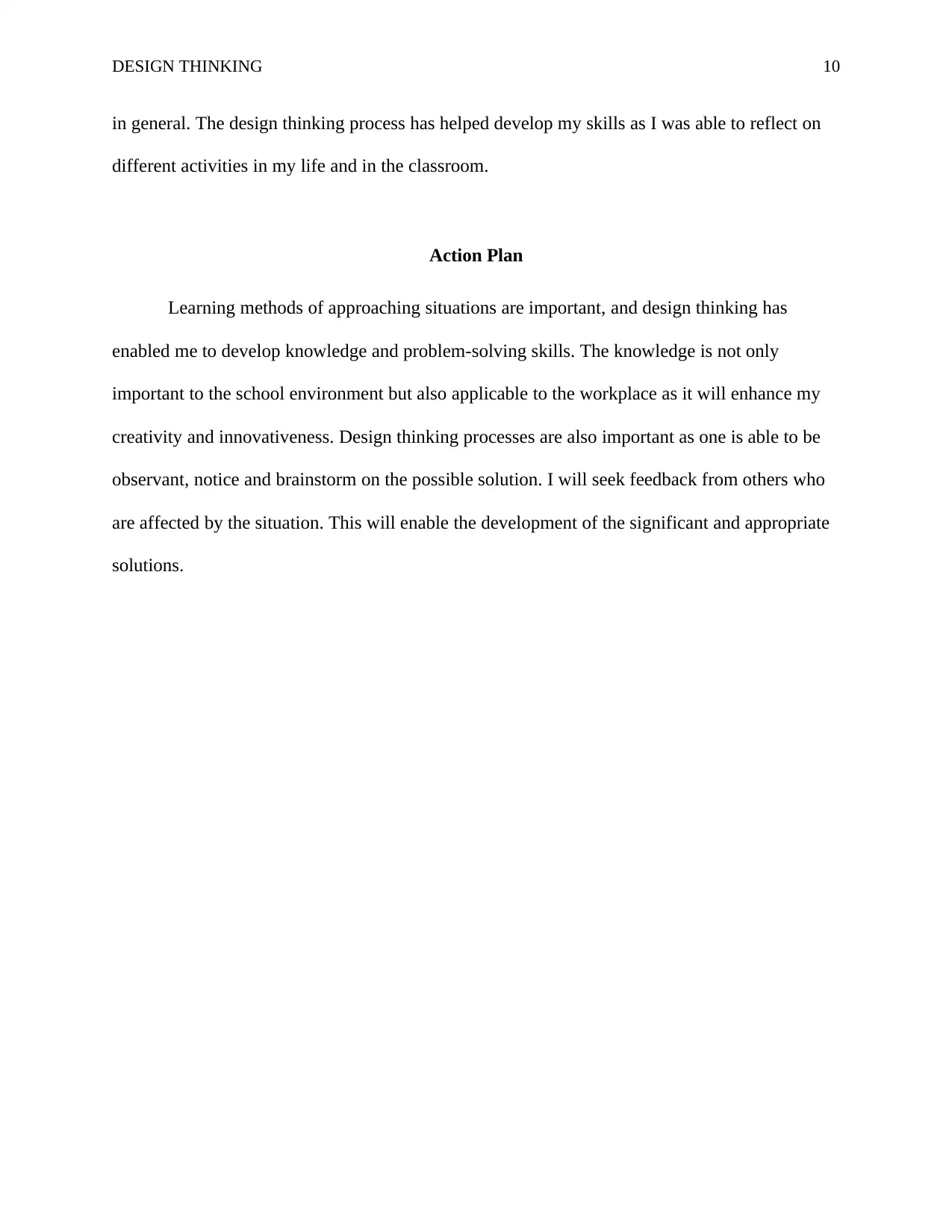
DESIGN THINKING 10
in general. The design thinking process has helped develop my skills as I was able to reflect on
different activities in my life and in the classroom.
Action Plan
Learning methods of approaching situations are important, and design thinking has
enabled me to develop knowledge and problem-solving skills. The knowledge is not only
important to the school environment but also applicable to the workplace as it will enhance my
creativity and innovativeness. Design thinking processes are also important as one is able to be
observant, notice and brainstorm on the possible solution. I will seek feedback from others who
are affected by the situation. This will enable the development of the significant and appropriate
solutions.
in general. The design thinking process has helped develop my skills as I was able to reflect on
different activities in my life and in the classroom.
Action Plan
Learning methods of approaching situations are important, and design thinking has
enabled me to develop knowledge and problem-solving skills. The knowledge is not only
important to the school environment but also applicable to the workplace as it will enhance my
creativity and innovativeness. Design thinking processes are also important as one is able to be
observant, notice and brainstorm on the possible solution. I will seek feedback from others who
are affected by the situation. This will enable the development of the significant and appropriate
solutions.
Paraphrase This Document
Need a fresh take? Get an instant paraphrase of this document with our AI Paraphraser
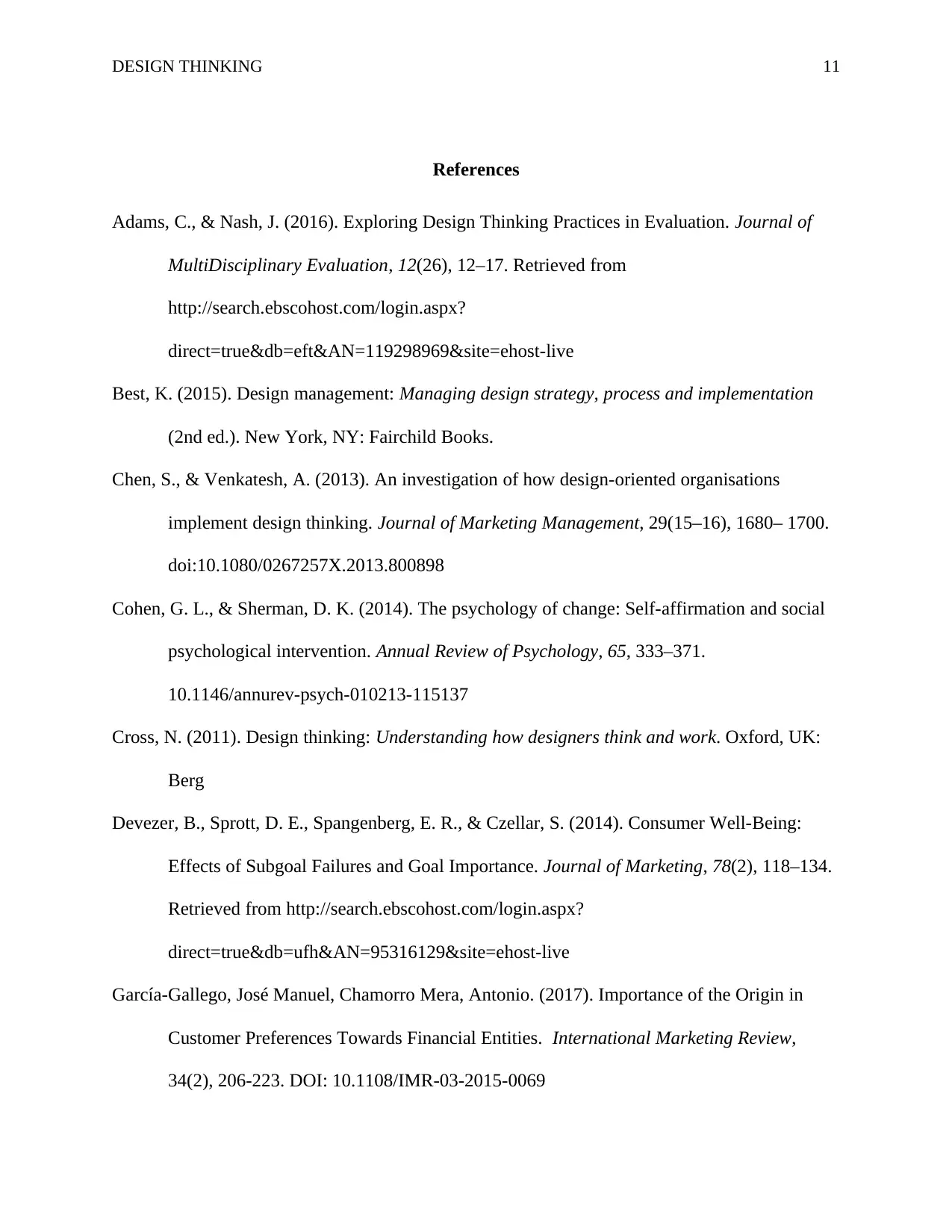
DESIGN THINKING 11
References
Adams, C., & Nash, J. (2016). Exploring Design Thinking Practices in Evaluation. Journal of
MultiDisciplinary Evaluation, 12(26), 12–17. Retrieved from
http://search.ebscohost.com/login.aspx?
direct=true&db=eft&AN=119298969&site=ehost-live
Best, K. (2015). Design management: Managing design strategy, process and implementation
(2nd ed.). New York, NY: Fairchild Books.
Chen, S., & Venkatesh, A. (2013). An investigation of how design-oriented organisations
implement design thinking. Journal of Marketing Management, 29(15–16), 1680– 1700.
doi:10.1080/0267257X.2013.800898
Cohen, G. L., & Sherman, D. K. (2014). The psychology of change: Self-affirmation and social
psychological intervention. Annual Review of Psychology, 65, 333–371.
10.1146/annurev-psych-010213-115137
Cross, N. (2011). Design thinking: Understanding how designers think and work. Oxford, UK:
Berg
Devezer, B., Sprott, D. E., Spangenberg, E. R., & Czellar, S. (2014). Consumer Well-Being:
Effects of Subgoal Failures and Goal Importance. Journal of Marketing, 78(2), 118–134.
Retrieved from http://search.ebscohost.com/login.aspx?
direct=true&db=ufh&AN=95316129&site=ehost-live
García-Gallego, José Manuel, Chamorro Mera, Antonio. (2017). Importance of the Origin in
Customer Preferences Towards Financial Entities. International Marketing Review,
34(2), 206-223. DOI: 10.1108/IMR-03-2015-0069
References
Adams, C., & Nash, J. (2016). Exploring Design Thinking Practices in Evaluation. Journal of
MultiDisciplinary Evaluation, 12(26), 12–17. Retrieved from
http://search.ebscohost.com/login.aspx?
direct=true&db=eft&AN=119298969&site=ehost-live
Best, K. (2015). Design management: Managing design strategy, process and implementation
(2nd ed.). New York, NY: Fairchild Books.
Chen, S., & Venkatesh, A. (2013). An investigation of how design-oriented organisations
implement design thinking. Journal of Marketing Management, 29(15–16), 1680– 1700.
doi:10.1080/0267257X.2013.800898
Cohen, G. L., & Sherman, D. K. (2014). The psychology of change: Self-affirmation and social
psychological intervention. Annual Review of Psychology, 65, 333–371.
10.1146/annurev-psych-010213-115137
Cross, N. (2011). Design thinking: Understanding how designers think and work. Oxford, UK:
Berg
Devezer, B., Sprott, D. E., Spangenberg, E. R., & Czellar, S. (2014). Consumer Well-Being:
Effects of Subgoal Failures and Goal Importance. Journal of Marketing, 78(2), 118–134.
Retrieved from http://search.ebscohost.com/login.aspx?
direct=true&db=ufh&AN=95316129&site=ehost-live
García-Gallego, José Manuel, Chamorro Mera, Antonio. (2017). Importance of the Origin in
Customer Preferences Towards Financial Entities. International Marketing Review,
34(2), 206-223. DOI: 10.1108/IMR-03-2015-0069
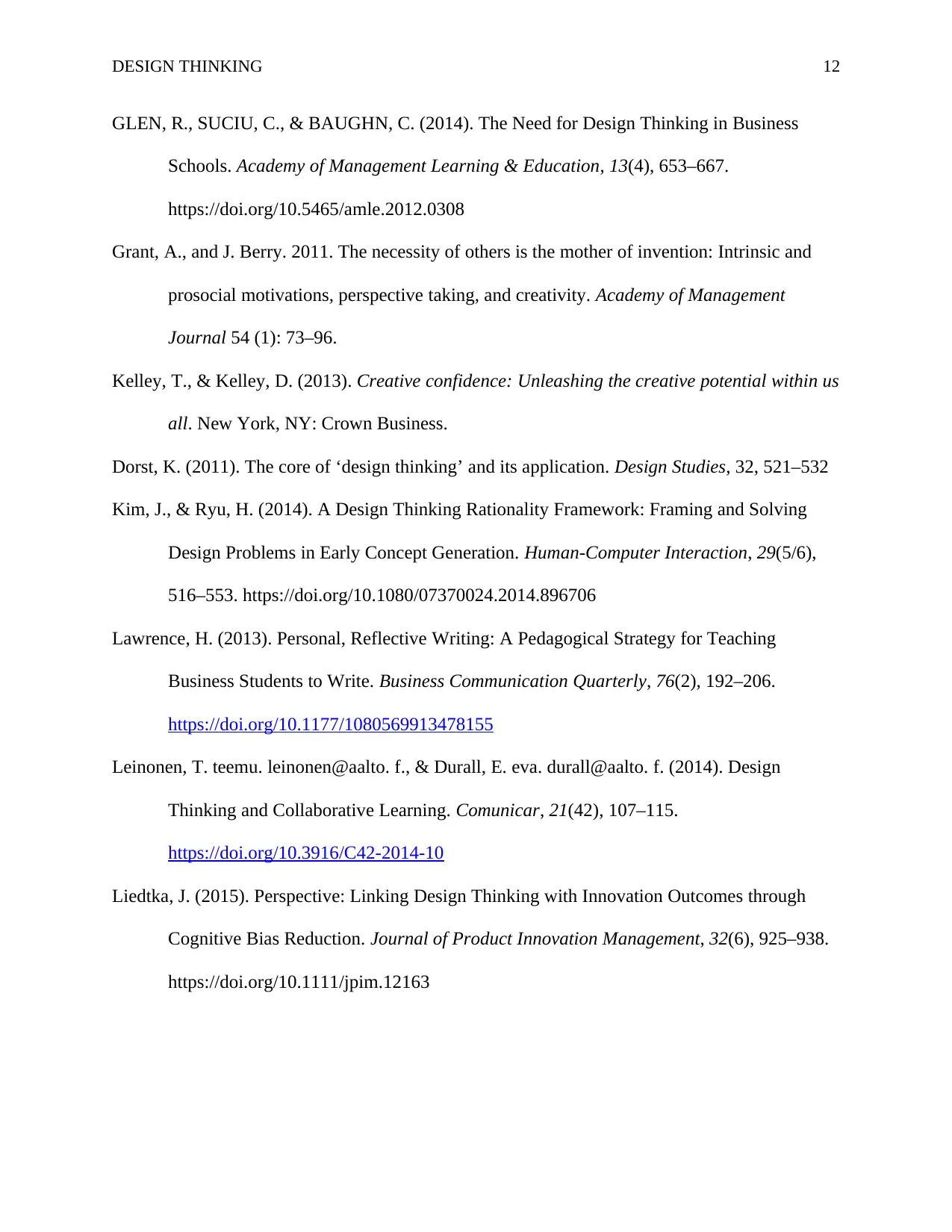
DESIGN THINKING 12
GLEN, R., SUCIU, C., & BAUGHN, C. (2014). The Need for Design Thinking in Business
Schools. Academy of Management Learning & Education, 13(4), 653–667.
https://doi.org/10.5465/amle.2012.0308
Grant, A., and J. Berry. 2011. The necessity of others is the mother of invention: Intrinsic and
prosocial motivations, perspective taking, and creativity. Academy of Management
Journal 54 (1): 73–96.
Kelley, T., & Kelley, D. (2013). Creative confidence: Unleashing the creative potential within us
all. New York, NY: Crown Business.
Dorst, K. (2011). The core of ‘design thinking’ and its application. Design Studies, 32, 521–532
Kim, J., & Ryu, H. (2014). A Design Thinking Rationality Framework: Framing and Solving
Design Problems in Early Concept Generation. Human-Computer Interaction, 29(5/6),
516–553. https://doi.org/10.1080/07370024.2014.896706
Lawrence, H. (2013). Personal, Reflective Writing: A Pedagogical Strategy for Teaching
Business Students to Write. Business Communication Quarterly, 76(2), 192–206.
https://doi.org/10.1177/1080569913478155
Leinonen, T. teemu. leinonen@aalto. f., & Durall, E. eva. durall@aalto. f. (2014). Design
Thinking and Collaborative Learning. Comunicar, 21(42), 107–115.
https://doi.org/10.3916/C42-2014-10
Liedtka, J. (2015). Perspective: Linking Design Thinking with Innovation Outcomes through
Cognitive Bias Reduction. Journal of Product Innovation Management, 32(6), 925–938.
https://doi.org/10.1111/jpim.12163
GLEN, R., SUCIU, C., & BAUGHN, C. (2014). The Need for Design Thinking in Business
Schools. Academy of Management Learning & Education, 13(4), 653–667.
https://doi.org/10.5465/amle.2012.0308
Grant, A., and J. Berry. 2011. The necessity of others is the mother of invention: Intrinsic and
prosocial motivations, perspective taking, and creativity. Academy of Management
Journal 54 (1): 73–96.
Kelley, T., & Kelley, D. (2013). Creative confidence: Unleashing the creative potential within us
all. New York, NY: Crown Business.
Dorst, K. (2011). The core of ‘design thinking’ and its application. Design Studies, 32, 521–532
Kim, J., & Ryu, H. (2014). A Design Thinking Rationality Framework: Framing and Solving
Design Problems in Early Concept Generation. Human-Computer Interaction, 29(5/6),
516–553. https://doi.org/10.1080/07370024.2014.896706
Lawrence, H. (2013). Personal, Reflective Writing: A Pedagogical Strategy for Teaching
Business Students to Write. Business Communication Quarterly, 76(2), 192–206.
https://doi.org/10.1177/1080569913478155
Leinonen, T. teemu. leinonen@aalto. f., & Durall, E. eva. durall@aalto. f. (2014). Design
Thinking and Collaborative Learning. Comunicar, 21(42), 107–115.
https://doi.org/10.3916/C42-2014-10
Liedtka, J. (2015). Perspective: Linking Design Thinking with Innovation Outcomes through
Cognitive Bias Reduction. Journal of Product Innovation Management, 32(6), 925–938.
https://doi.org/10.1111/jpim.12163
⊘ This is a preview!⊘
Do you want full access?
Subscribe today to unlock all pages.

Trusted by 1+ million students worldwide
1 out of 14
Related Documents
Your All-in-One AI-Powered Toolkit for Academic Success.
+13062052269
info@desklib.com
Available 24*7 on WhatsApp / Email
![[object Object]](/_next/static/media/star-bottom.7253800d.svg)
Unlock your academic potential
Copyright © 2020–2025 A2Z Services. All Rights Reserved. Developed and managed by ZUCOL.




